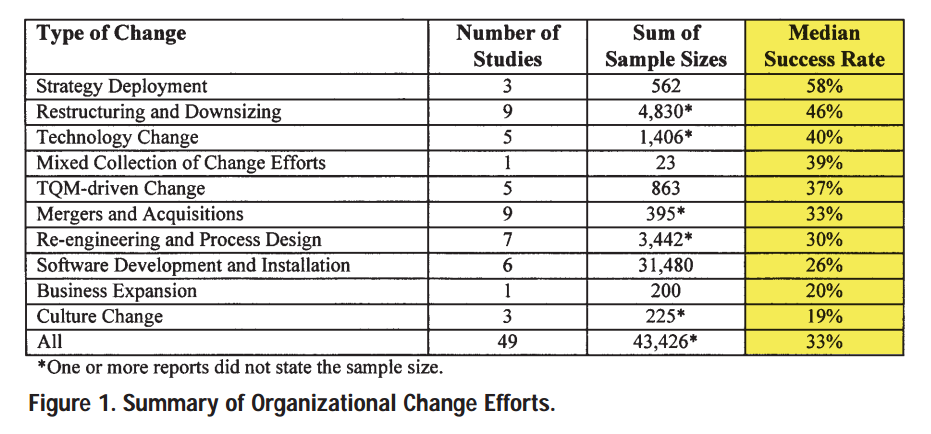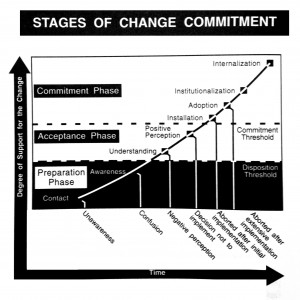
Beginning in 1995, a number of studies began to surface reporting high failure rates of organizational change initiatives. Since then, countless experts have used the statistic as gospel, arguing that only 30% of major change projects fully succeed.
While some see this mostly as a scare tactic to help change professionals sell their own solutions or services, the number of successful change initiatives is not encouraging. The disappointing success rate reminds us that it is extremely challenging work to get through the predictable obstacles (and unintended consequences) to get change to occur and then stick.
Change, By the Numbers
Change comes in many shapes and sizes, but the International Society for Performance Improvement (2002) had a fascinating research-based perspective of success rates based on types of organizational change:

For full report, visit http://www.ispi.org/pdf/Vol41_01_26.pdf/
Not the most encouraging list of statistics ever, but it does at least shed some light on two things:
- Certain type of change have a better chance of being considered a success, and
- the types of metrics used to consider something a “success” likely vary greatly from one type of change to the next.
No One Likes to Talk About Failure
As humans, we prefer to focus on the good things in life, the success stories and case studies. We look to them as proof that if we follow their formulas and processes – and implement them in our own organizations – we, too, can beat the odds.
In some cases, using these learnings and best practices can be quite useful. But as leaders, we also need to be wary of false pattern recognition and assuming that a cookie-cutter approach to change will work for our unique situations.
The Biggest Problem with Change
Even if the 70% statistic is inflated, why is success so difficult to achieve when implementing change within organizations? The answer is as complex as the organizations who decide to tackle it head-on.
The biggest problem with change is that “success” isn’t black and white.
What constitutes “failure”?
Does it mean that the entire initiative was a bust, and everything reverted back to the way things were before?
Does it mean that the change didn’t take place by the intended deadline?
Was it over budget (by a little, or a lot)?
As Vince Lombardi, legendary football coach of the Green Bay Packers, once said:
“In my entire career, I never lost a single game. I just ran out of time.”
Give Change a Fighting Chance
Change is a process. It doesn’t happen overnight or by some random date chosen in the future. It evolves because the dynamics of teams and organizations evolve, too.
Momentum is your biggest asset during the change process. You have to draw on a clear plan—and your personal power—to get others to take the risk of changing. You need to build powerful business relationships to carry you – and the organization – through.
To give your change process the momentum it needs and improve its chances of being a success, consider implementing (some, or all of) our five keys to powerful business relationships:
- connect first
- walk in another’s shoes
- trust is up to you
- share information, and
- manage yourself before managing others.
To learn more about “Five Keys to Powerful Business Relationships,” visit our dedicated website.
Photo courtesy of Sebastiaan ter Burg.





